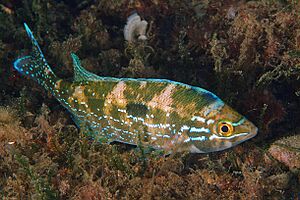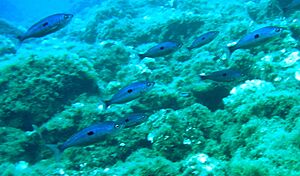Blotched picarel facts for kids
Quick facts for kids Blotched picarel |
|
|---|---|
 |
|
| Blotched picarel male spawning | |
| Conservation status | |
| Scientific classification | |
| Genus: |
Spicara
|
| Species: |
maena
|
| Synonyms | |
|
|
The blotched picarel, known scientifically as Spicara maena, is a type of ray-finned fish. This fish lives in the eastern Atlantic Ocean, the Mediterranean Sea, and the Black Sea. Male blotched picarels can grow up to about 25 cm (10 in) long. Females are a bit smaller, reaching about 21 cm (8 in). People catch this fish for food in some areas.
Contents
About the Blotched Picarel
What's in a Name?
The scientific name for this fish is Spicara maena. The genus name, Spicara, is a common name for fish like picarels in Italy. It might come from the word spica, meaning "a spike." The specific name, maena, comes from an Ancient Greek name for picarels. This name has been used since the time of Aristotle.
How to Identify a Blotched Picarel
The blotched picarel has a body that is fairly deep from top to bottom. Males are usually larger than females. Their upper jaw can stick out, and their mouth has many small teeth.
They have one dorsal fin with eleven spines and twelve soft rays. The anal fin has three spines and nine or ten soft rays. Along its side, there are 68 to 70 scales on its lateral line.
The fish is blue-grey on top and silvery on its sides. It has small dark spots scattered across its body. You can usually see one large dark blotch right above its pectoral fin. This fish can look different depending on where it lives. It is sometimes confused with the common picarel, Spicara smaris.
Where Do Blotched Picarels Live?
You can find Spicara maena in the eastern Atlantic Ocean, the Mediterranean Sea, and the Black Sea. In the Atlantic, they live from Morocco and the Canary Islands up to Portugal. They usually live at depths of about 30 to 90 meters (98 to 295 ft). These fish prefer to live near the seabed. They like sandy or muddy bottoms and areas with seagrass meadows.
Life and Habits of the Blotched Picarel
Blotched picarels are social fish. They often swim together in groups called schools. They eat small creatures that live on the seabed, called benthic invertebrates, and tiny animals floating in the water, called zooplankton.
This fish is a special type of hermaphrodite. This means it starts its life as a female and later changes into a male. Studies have shown that there are many more females than males. The change from female to male usually happens when the fish reaches a certain size. For example, in the Aegean Sea, this change often occurs when the fish is about 14.5 to 15 cm (5.7 to 5.9 in) long. All blotched picarels longer than 18 cm (7.1 in) are typically male.
Female blotched picarels become ready to reproduce when they are about two years old. They lay their eggs between March and June in the Aegean Sea. Further west in the Mediterranean, they lay eggs between August and October. The male fish digs a small hollow in the seabed. The female then lays her eggs in this nest. The eggs have a sticky surface, which helps them stay in the nest.



